Archives: Projects
Nanjing Metro Line 3 Lot 11 & Line 10 Lot 5
Project Overview
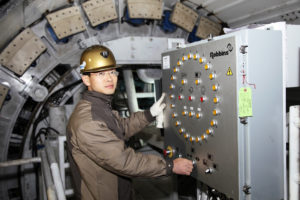 The world-famous Youth Olympic Games were held in Nanjing in summer 2014, bringing 40,000 visitors. This number, combined with the 750,000 people who rode the city’s rails on a daily basis, put the city in need of an extended metro system.
The world-famous Youth Olympic Games were held in Nanjing in summer 2014, bringing 40,000 visitors. This number, combined with the 750,000 people who rode the city’s rails on a daily basis, put the city in need of an extended metro system.
Two new metro lines were built to accommodate the anticipated increase in passengers. Robbins supplied four 6.5 m (21.4 ft) diameter EPBs with mixed ground cutterheads for Line 3 Lot 11 and Line 10 Lot 5, 40.2 km (25.0 mi) and 41.4 km (25.7 mi) long, respectively. The EPBs were part of about 40 TBMs used for the Nanjing Metro expansion.
Ground Conditions
Both lines were bored in soft ground consisting of silty sand, sandstone, small pebbles and man-made materials. The Qinhuai River, old historical structures, a railway and a viaduct were in close vicinity of the lines. Due to the ground conditions and nearby structural constraints, customized excavation methods were employed. The thrust force was kept very low at 6,000 to 9,000 kN (1.4 to 2.0 million lb), continuous monitoring was used to maintain proper alignment and earth pressure, and foam additive was applied to make the ground less sticky and reduce torque.
Excavation
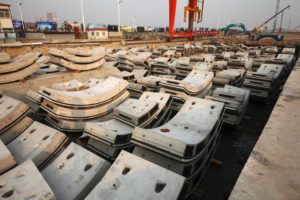 Two of the four 6.5 m (21.4 ft) diameter TBMs were launched for the 2,500 m (8,202 ft) Line 10 Lot 5 in December 2011 and February 2012. The second pair of machines for 2,030 m (6,660 ft) Line 3 Lot 11 began boring soon after in January and March 2012. All machines were assembled and launched from 10 m (33 ft) shafts.
Two of the four 6.5 m (21.4 ft) diameter TBMs were launched for the 2,500 m (8,202 ft) Line 10 Lot 5 in December 2011 and February 2012. The second pair of machines for 2,030 m (6,660 ft) Line 3 Lot 11 began boring soon after in January and March 2012. All machines were assembled and launched from 10 m (33 ft) shafts.
By August 2012, the Line 10 EPBs had excavated 720 m and 600 m (2,362 ft and 1,968 ft), with advance rates of 40 mm (1.6 in) per minute. Over at Line 3, the excavation had progressed as far as 600 m (1,968 ft) with rates topping 60 mm (2.4 in) per minute. Settlement for both lines stayed below the strict required limits of less than 20 mm (0.8 in). By 2013, all four machines had completed their respective tunnels with very favorable results.
The new Lines 3 and 10, now complete, combine with Nanjing’s two existing metro lines to handle the increase in rail riders. The lines will also serve as part of the municipal government’s extensive plan to build 17 new rail routes totaling 600 km (370 mi) across the Yangtze River Basin by 2030.
Shayler Run Segment C Sewer Replacement Project
Project Overview
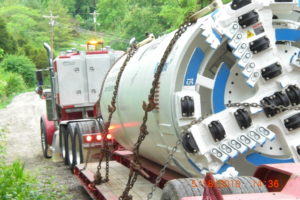 Seven new sewer tunnels were recently completed in Ohio’s Clermont County, replacing an outdated and exposed system that was dumping raw sewage into local Shayler Creek. Since 1978, when the previous pipeline was installed, the creek had eroded, exposing the pipe and putting certain sections of the line at high risk of failure. For all of these reasons, a new pipeline needed to be installed far below the environmentally-sensitive waterway.
Seven new sewer tunnels were recently completed in Ohio’s Clermont County, replacing an outdated and exposed system that was dumping raw sewage into local Shayler Creek. Since 1978, when the previous pipeline was installed, the creek had eroded, exposing the pipe and putting certain sections of the line at high risk of failure. For all of these reasons, a new pipeline needed to be installed far below the environmentally-sensitive waterway.
The Clermont County Water Resources Department hired Indianapolis contractor Midwest Mole for the $15M USD project, and chose to use only one machine for the seven tunnels. A 1.8 m (72 in) diameter Robbins Double Shield Rockhead was used to excavate all of the tunnels, totaling 2,900 m (9,513 ft). The contractor’s unique approach also included eliminating three shafts from the original bid, which shortened the project schedule and significantly lowered costs.
Ground Conditions
Because of the project location below the creek bed, ground conditions were highly varied, consisting of interbedded layers of limestone and shale that ranged from dry to sticky and wet. To accommodate the mixed ground, the machine was outfitted with a mixed ground cutterhead that could be swapped out for a hard rock cutterhead based on the ground conditions at each crossing.
The mixed ground cutterhead featured 6.5 in single disc cutters and carbide bits, while the hard rock cutterhead contained 11.5 in single cutters and abrasion-resistant muck scrapers. Both cutterheads had large openings which allowed for efficient cutter changes.
About the SBU-RHDS
The Robbins Double Shield Rockhead (SBU-RHDS) is a tunneling machine typically used on utility installations of over 150 m (500 ft). Its continuous steering capabilities and laser targeting system make it the ideal solution for line-and-grade critical installations such as the Shayler Run Segment C Sewer Replacement Project.
The SBU-RHDS is available in diameters from 1.4 to 2.0 m (54 to 78 in), and consists of a cutterhead optimized for mixed and hard rock ground conditions. The machine’s circular cutterhead contains disc cutters capable of excavating ground ranging from 25 to 175 MPa (4,000 to over 25,000 psi) UCS.
As the cutterhead rotates, the cutters penetrate the rock face creating “crush zones” through which fractures propagate. Material between adjacent crush zones is then chipped from the face. Muck scrapers scoop the muck into muck buckets, which transfer the muck onto a machine belt conveyor. Muck is transported offsite via conveyor belt or muck cars.
Excavation
 A total of seven tunnel crossings connected by eight shafts were constructed by Midwest Mole. The tunnels utilized the Rockhead, while the shafts were constructed using a combination of drill and blast techniques and manual excavation. A primary liner of ring beams and lagging was installed every 1.5 m (5 ft) at each crossing. Even with liner installation, high production rates of 12 to 18 m (40 to 60 ft) per 12-hour shift were maintained for the project duration.
A total of seven tunnel crossings connected by eight shafts were constructed by Midwest Mole. The tunnels utilized the Rockhead, while the shafts were constructed using a combination of drill and blast techniques and manual excavation. A primary liner of ring beams and lagging was installed every 1.5 m (5 ft) at each crossing. Even with liner installation, high production rates of 12 to 18 m (40 to 60 ft) per 12-hour shift were maintained for the project duration.
Due to the gravity sewer construction, each tunnel had strict line-and-grade requirements of within 300mm (1 ft) of line at 1 to 2% grade, which was continuously monitored from an in-shield operator’s console. Over the course of the project, the variance resulted in a vertical change of 53.9 m (177 ft) causing the machine to bore through a wide range of ground conditions.
Excavation of the initial 484.3 m (1,589 ft) crossing began in May 2010 in mixed ground, and the Rockhead broke through to its first shaft site that August. After a few minor modifications to the hydraulic and muck haulage systems, the machine began boring the second 575.4 m (1,888 ft) crossing.
Crossings 3 and 4, 321.9 m (1,056 ft) and 304.8 m (1,000 ft), respectively, were excavated in December 2010 and January 2011 in adverse winter weather conditions. In order to keep tunneling during freezing temperatures, the contractor heated the machine’s cooling water overnight. Cooling water was recycled and filtered, then stored in 7, 500 l (2,000 gal) tanks with heaters. Using this technique, production rates stayed high and both crossings were successfully excavated by January 2011.
The Rockhead began its fifth and longest crossing of 613.8 m (2,014 ft) in April 2011, and reached a world record in tunneling distance for a hard rock machine of its 1.8 m (72 in) diameter. For the last two crossings, 402.3 m (1,320 ft) and 196.9 m (646 ft), respectively, the mixed ground cutterhead was replaced with its hard rock counterpart.
Due to negotiations with local landowners and a change in shaft location, the final crossing began in January 2012. A month later, the drive was completed. In July 2012, the entire project reached completion right on schedule, with all manholes and ancillary sewers tied in and in service.
Moscow Metro
Project Overview
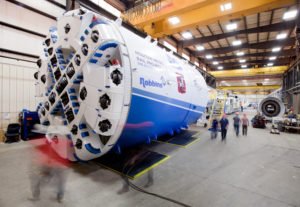 Travel times of over two hours are daily routine for Moscow’s commuters. With a growing population of nearly 12 million, the Moscow Government has issued an extensive city-wide metro project, totaling 50 km (31 mi) of new track by 2018.
Travel times of over two hours are daily routine for Moscow’s commuters. With a growing population of nearly 12 million, the Moscow Government has issued an extensive city-wide metro project, totaling 50 km (31 mi) of new track by 2018.
A total of five Robbins EPBs have bored multiple tunnel drives on the Moscow Metro. Combined, the EPBs have bored more than 8km of tunnel.
Machine Design
All TBMs have been custom designed to handle the area’s complex geology of fine sand, gravel, sandy loam, stiff clays and limestone. Each TBM is equipped with a mixed ground cutterhead capable of switching out carbide cutting tools with disc cutters, depending on conditions.
Besides their mixed ground capabilities, each EPB will utilize a Robbins continuous conveyor system for maximum efficiency during muck removal. Surface monitoring devices will also be employed to limit settlement due to the project’s densely urban environment in the heart of Moscow.
These machines are the first to use electric variable frequency drives (VFDs) in Moscow. The high thrust and torque capabilities of the machines allow for faster excavation while minimizing disturbance that can lead to surface settlement. Active articulation on the machines enables them to excavate tighter curves without the risk of segment deformation that is present when using passive articulation.
Excavation
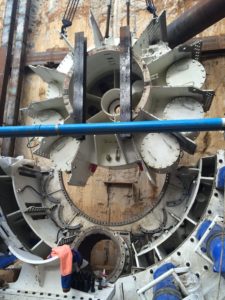 Tunneling occurred at dozens of compact jobsites characterized by Moscow’s challenging mixed ground conditions. Three new Robbins High Performance EPBs and one refurbished machine, named “Julia” operated in various areas of the city. The machines were customized to excavate in the city’s difficult mixed ground geology.
Tunneling occurred at dozens of compact jobsites characterized by Moscow’s challenging mixed ground conditions. Three new Robbins High Performance EPBs and one refurbished machine, named “Julia” operated in various areas of the city. The machines were customized to excavate in the city’s difficult mixed ground geology.
Three Robbins EPB machines were contracted under Engeocom; two 6.6 m diameter machines excavated left and right-hand tunnels, each 1.8 km in length, and “Julia” excavated a 2 km section of a tunnel. A fourth machine contracted under USK MOST is a 6.2 m diameter machine with mixed ground cutterhead that bored a 1.9 km section of a tunnel. All four Robbins machines have also utilized Robbins continuous conveyors for the mixed ground conditions.
When the fourth Robbins machine was launched in winter 2012 from a 15 m deep shaft, contractor USK MOST needed to bore through ground conditions consisting of dense clay and fine sand. They used foam and conditioner to keep the earth balanced, and ultimately for easier muck removal. Not only were they able to keep up with the project’s challenges, but the machine also achieved milestone rates of 150 m in one week, and up to 500 m per month in spring 2013. Experienced crew members, a rigorous schedule, implementation of the continuous conveyor, and the reliability of the Robbins TBM are all factors that helped achieve the record.
Robust Machines, Multiple Drives
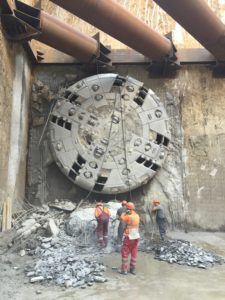 The Robbins EPB for USK MOST made its breakthrough on May 24, 2013. City officials and contractors celebrated not only a record-breaking achievement for the 6.2 m (20.3 ft) diameter mixed ground machine but also finishing ahead of schedule. The TBM achieved a 37.8 m (124 ft) advance in one day at the end of April 2013 – a Russian record for EPBs in the 6 to 7 m (20 to 23 ft) diameter range.
The Robbins EPB for USK MOST made its breakthrough on May 24, 2013. City officials and contractors celebrated not only a record-breaking achievement for the 6.2 m (20.3 ft) diameter mixed ground machine but also finishing ahead of schedule. The TBM achieved a 37.8 m (124 ft) advance in one day at the end of April 2013 – a Russian record for EPBs in the 6 to 7 m (20 to 23 ft) diameter range.
In 2015, a fifth Robbins EPB was added to the mix. The machine was assembled using Onsite First Time Assembly (OFTA) for contractor Evrascon. It bored 4 km of tunnel in hard clay, sand, gravel, pebbles, hard limestone with water, and loam, breaking through in May 2016.
On October 24, 2015, another milestone was reached at the Moscow Metro. A 6.65 m (21.8 ft) diameter Robbins EPB completed its second tunnel, measuring 2.5 km (1.6 mi). The TBM made a breakthrough at its first 2.1 km (1.3 mi) long tunnel drive in January 2014. Contractor SMU Engeocom plans to use the machine on a third tunnel—and that will not be the first time that an EPB has been used on multiple drives at Moscow Metro. Engeocom owns another 6.65 m (21.8 ft) Robbins EPB that completed its second tunnel at the end of September 2015, and will also go on to bore extra tunnels.
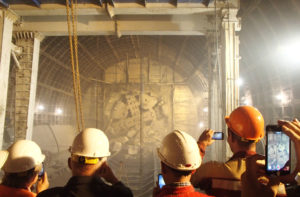
On February 01, 2017 the record-setting Robbins EPB originally for USK MOST started excavation of its fourth bore on the Moscow Metro Project. Its new tunnel will be about 2 km long and will connect stations “Kosino” and “Ulitsa Dmitrievskogo” on the new “Kozhukhovskaya” metro line. The geology is very difficult in this area and running sands are expected. In addition the machine will drive under existing railway tracks. The machine is currently owned by MIP-Story #1 Company—an affiliate of Mosinzhproekt – Main Contractor and Design Institute on the Moscow Metro Project.
The robust Robbins EPBs are capable of even more mixed ground tunnels for the Moscow Metro.
Recent Posts
- Twin Robbins EPBs make milestones near Taj Mahal
- Long Haul TBM: Use of a Rebuilt Main Beam Machine at the DigIndy Tunnel System in Indianapolis, IN
- Evaluating TBM Design and Performance, 30 Years Apart: The Lesotho Highlands Water Tunnel, Phase 1 and Phase 2
- Overcoming Mountainous Geology at Nepal's Sunkoshi Marin Project
- Swift Robbins TBM breaks through 11 Months Early

 Close
Close  Menu
Menu 